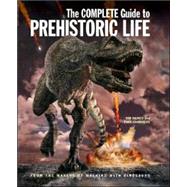
| The Rise of Life | p. 8 |
| Cambrian Period (543 to 490 mya) | |
| Anomalocaris | p. 16 |
| Trilobites | p. 18 |
| Haikouichthys | p. 20 |
| Ordovician Period (490 to 443 mya) | |
| Cameraceras | p. 21 |
| Megalograptus | p. 22 |
| Silurian Period (443 to 417 mya) | |
| Cephalaspis | p. 23 |
| Brontoscorpio | p. 24 |
| Pterygotus | p. 25 |
| Devonian Period (417 to 354 mya) | |
| Dunkleosteus | p. 26 |
| Stethacanthus | p. 28 |
| Hynerpeton | p. 30 |
| Hyneria | p. 32 |
| Carboniferous Period (354 to 290 mya) | |
| Meganeura | p. 34 |
| Petrolacosaurus | p. 36 |
| Arthropleura | p. 37 |
| Proterogyrinus | p. 38 |
| Permian Period (290 to 248 mya) | |
| Dimetrodon | p. 40 |
| Seymouria | p. 42 |
| Edaphosaurus | p. 43 |
| Gorgonops | p. 44 |
| Scutosaurus | p. 46 |
| Diictodon | p. 48 |
| The Age of Reptiles | p. 50 |
| Triassic Period (248 to 206 mya) | |
| Proterosuchus | p. 58 |
| Lystrosaurus | p. 60 |
| Euparkeria | p. 62 |
| Nothosaurus | p. 64 |
| Cymbospondylus | p. 65 |
| Tanystropheus | p. 66 |
| Plateosaurus | p. 67 |
| Placerias | p. 68 |
| Thrinaxodon | p. 69 |
| Coelophysis | p. 70 |
| Peteinosaurus | p. 72 |
| Postosuchus | p. 74 |
| Jurassic Period (206 to 144 mya) | |
| Ammonites | p. 76 |
| Leedsichthys | p. 78 |
| Metriorhynchus | p. 80 |
| Rhamphorhynchus | p. 82 |
| Opthalmosaurus | p. 84 |
| Liopleurodon | p. 86 |
| Cryptoclidus | p. 88 |
| Hybodus | p. 89 |
| Eustreptospondylus | p. 90 |
| Othnielia | p. 91 |
| Diplodocus | p. 92 |
| Brachiosaurus | p. 94 |
| Anurognathus | p. 95 |
| Stegosaurus | p. 96 |
| Allosaurus | p. 98 |
| Ornitholestes | p. 100 |
| Cretaceous Period (144 to 65 mya) | |
| Iguanodon | p. 102 |
| Tapejara | p. 104 |
| Polacanthus | p. 105 |
| Iberomesornis | p. 106 |
| Utahraptor | p. 107 |
| Ornithocheirus | p. 108 |
| Koolasuchus | p. 110 |
| Leallynasaura | p. 112 |
| Sarcosuchus | p. 114 |
| Giganotosaurus | p. 116 |
| Argentinosaurus | p. 118 |
| Pteranodon | p. 120 |
| Therizinosaurus | p. 122 |
| Tarbosaurus | p. 124 |
| Mononykus | p. 125 |
| Velociraptor | p. 126 |
| Protoceratops | p. 128 |
| Archelon | p. 130 |
| Elasmosaurus | p. 131 |
| Tylosaurus | p. 132 |
| Xiphactinus | p. 134 |
| Hesperornis | p. 135 |
| Tyrannosaurus | p. 136 |
| Torosaurus | p. 138 |
| Ankylosaurus | p. 140 |
| Anatotitan | p. 142 |
| Didelphodon | p. 143 |
| The Age of Beasts | p. 144 |
| Palaeocene Epoch (65 to 55 mya) | |
| Gastornis | p. 152 |
| Eocene Epoch (55 to 34 mya) | |
| Leptictidium | p. 154 |
| Godinotia | p. 155 |
| Propalaeotherium | p. 156 |
| Ambulocetus | p. 158 |
| Andrewsarchus | p. 160 |
| Embolotherium | p. 162 |
| Moeritherium | p. 163 |
| Arsinoitherium | p. 164 |
| Basilosaurus | p. 166 |
| Dorudon | p. 168 |
| Apidium | p. 169 |
| Oligocene Epoch (34 to 24 mya) | |
| Hyaenodon | p. 170 |
| Entelodon | p. 172 |
| Indricotherium | p. 174 |
| Cynodictis | p. 176 |
| Miocene Epoch (24 to 5 mya) | |
| Chalicotherium | p. 177 |
| Deinotherium | p. 178 |
| Pliocene Epoch (5 to 1.8 mya) | |
| Ancylotherium | p. 180 |
| Dinofelis | p. 181 |
| Australopithecus afarensis | p. 182 |
| Carcharodon megalodon | p. 184 |
| Odobenocetops | p. 186 |
| Smilodon | p. 188 |
| Phorusrhacos | p. 190 |
| Megatherium | p. 192 |
| Macrauchenia | p. 194 |
| Doedicurus | p. 195 |
| Pleistocene Epoch (1.8 mya to 10,000 years ago) | |
| Megaloceros | p. 196 |
| Panthera leo | p. 197 |
| Homo neanderthalensis | p. 198 |
| Mammuthus | p. 200 |
| Coelodonta | p. 202 |
| Homo sapiens | p. 204 |
| Homo floresiensis | p. 206 |
| Timescale of the Earth | p. 207 |
| Tree of Life diagrams | p. 208 |
| Acknowledgements | p. 212 |
| Index | p. 213 |
| Table of Contents provided by Ingram. All Rights Reserved. |
The New copy of this book will include any supplemental materials advertised. Please check the title of the book to determine if it should include any access cards, study guides, lab manuals, CDs, etc.
The Used, Rental and eBook copies of this book are not guaranteed to include any supplemental materials. Typically, only the book itself is included. This is true even if the title states it includes any access cards, study guides, lab manuals, CDs, etc.